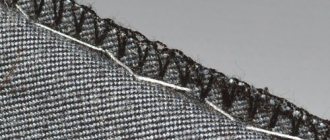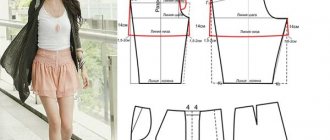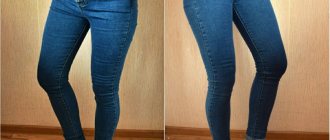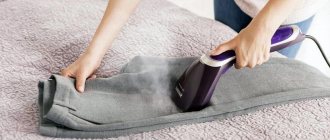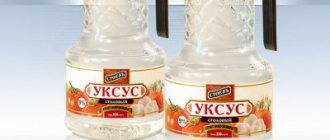What types of tapes are used for hemming trousers?
It is not always possible to buy pants that fit your height. Therefore, after purchasing, many people have to shorten the legs to fit their size. Special tapes that are used to process the edges of the product will help in this process.
Hot-melt adhesive tapes are made from polyamide, which is a strong adhesive compound. To hem the pants, use double-sided tape, your choice of white or black. Using a web for fabric is quite simple. It is glued using a hot iron. There are several varieties with which you can hem the bottom of your pants.
- paper based;
- cobweb without paper base;
- braid;
- grosgrain ribbon.
An adhesive pad will be the best option when you don’t have a sewing machine at hand. The principle of operation is quite simple. The web is made of a special adhesive composition that melts under high temperature and then hardens.
All you need is an iron and a flat surface. The tape is laid between two layers of any fabric and ironed several times. After this, the glue fixes the material, and the trousers are hemmed in a matter of minutes. Adhesive tape can be used in several cases:
- for minor clothing repairs;
- fixing applications on the surface of the fabric;
- for hemming trousers if there is no sewing equipment;
When hemming pants made of any material, after gluing the tape, there will be no threads sticking out at the edges. Therefore, this option is suitable even if the edges are not overlocked.
It should be noted that fabric can be glued not only with the help of cobwebs. For example, for some types the use of rubber-based glue is permitted. This is an excellent option for gluing thick fabrics and leather.
Also, the consistency is not afraid of high and low temperatures. You can use “liquid thread” glue, which does not damage the fabric, dries very quickly and provides highly effective gluing.
Similar materials are dublerin and non-woven fabric, which can reliably glue parts of clothing together. They differ in density and composition, so you need to consider the type of fabric.
It should be noted that this type of material is several times denser than standard spider web, but the gluing force is less. The adhesive gasket is much more reliable and easier to use. Therefore, people who are far from sewing can use it.
To have a more accurate idea, you should consider in detail each type of finishing tape.
Braid or grosgrain ribbon
Almost every seamstress used braid to sew trousers in ancient times. This is a strong tape that is sewn onto the bottom of the trouser legs, thereby strengthening the seams and increasing strength. Nowadays, products with braid at the bottom can only be found in expensive stores. To work with braid, you need a sewing machine.
Before hemming the braid to the trousers, it must be decated. In a loose state, without tension, treat with steam. This must be done so that the tape does not shrink after washing. Otherwise, the trousers will lose their shape.
Rep tape is particularly durable. It differs from any other varieties by pronounced pepper ridges. It is able to hold its shape perfectly, does not stretch or deform. The density of grosgrain tape may vary depending on the variety.
Some useful tips
- Practical use shows that the web can come off after several washes. In this case, you just need to do the above processes again. This must be taken into account and, if possible, apply adhesive tape to products that are less susceptible to washing and have less contact with water.
- When washing items with cobwebs, avoid high temperatures.
- There are unpleasant situations when, during the ironing process, the adhesive composition remains on the iron. A small piece of cloth soaked in an alcohol solution will come in handy here. It removes glue residue perfectly. To avoid staining the iron, it is recommended to use a thin cloth or gauze. This way, the iron will be protected and will not have to be cleaned.
The web is very easy to use and is an indispensable material. We hope that this article will help you properly shorten your pants in a simple and convenient way.
Pattern of a kimono robe with wrap and sleeves
Knitting patterns for women's jumpers
How to hem men's trousers with braid
If the trousers are long and do not fit a person’s height, they can be hemmed in several ways. When you can’t visit a studio or don’t have a sewing machine at home, you can shorten your pants with adhesive tape.
It is important to know that trousers made from expensive fabrics are hemmed exclusively with braid using a sewing machine. Therefore, in this case, adhesive tape will not work.
Rep tape requires certain sewing skills, as well as the availability of appropriate equipment. The process of sewing on the braid is complex, but is considered a durable and reliable option. It should be noted that trousers can be hemmed both in the round and exclusively from the back. If you urgently need to shorten your trouser legs, you can do this yourself using a spider web.
How to try on pants
The crucial moment in hemming is fitting. It is important to remember that before trying on trousers and marking the required length, they need to be steamed or washed. Most fabrics shrink after the first wash. Therefore, if this procedure is not carried out, after hemming the pants will become short and unsuitable for wear.
- It is necessary to try on only with shoes and a belt, if one has been used before. Otherwise, the length may be measured incorrectly.
- Men's trousers should end at the middle or beginning of the heel, this is considered the optimal length. They won't drag on the ground and won't look short. When trying on trousers without boots, the length of the trouser leg should touch the floor. If the trousers are short and tight, then the length is shortened so that there are no folds at the bottom.
- To measure the desired length, the bottom of the trouser leg is pinned outward when trying on.
- As a rule, the front half of the trousers should be 1 or 1.5 cm shorter than the back half.
Stages of preparing the bottom of the trousers to sew on the tape
You can shorten your trouser legs yourself if you follow all the recommendations and be careful. Every novice seamstress should know that before starting work, the product must be carefully ironed.
- Choose a wide, flat surface to work on.
- Be sure to turn the pants inside out and fold them in half.
- It is necessary to navigate along the belt line, since the lower part of the pants is not always level, even if they are factory-made.
- The trouser legs need to be folded together along the side seams and pinned.
- Using chalk or soap, draw a line from one pin to another using a ruler.
- To prevent the lines from being erased when manipulating the trousers, you need to lay a line on them with stitches approximately 0.5 cm in size.
- Now you need to measure the distance from the drawn hem line by 4 cm.
- Once the hem line is drawn, the remaining excess fabric is cut off.
- Align the pants with the waist and place them on a flat, comfortable surface.
- The lower cut must be processed to prevent the threads from shedding. This will require an overlocker, but if you don’t have one, you can overcast it by hand with a simple seam.
- To make it more convenient to work with the fabric, the bends must be ironed.
What is it and where is it used
This tape is not an analogue of dublerin, because is a set of glue threads connected to each other into a thin layer, forming a single web, which allows you to cut out a part of any configuration and size from it. Under the influence of heat, the glue begins to melt and spread over the surface of the material. Drying after a while, the glue holds the parts together.
Cobwebs for clothing repair are actively used in the clothing industry at 2 levels:
- individual (in sewing studios);
- mass (in garment factories).
It serves as a cushioning and gluing material for cut parts that cannot or should not be joined in any other way (for example, by hand or machine basting). Most often, this method of laying and fastening parts is used in sewing in clothing factories. It allows you to reduce production costs and reduce the cost of the final product.
How to tape the hem of men's trousers with adhesive tape
To make the trousers look aesthetically pleasing and beautiful, you need to choose a web tape that matches the color of the fabric. If you glue light-colored trousers with dark tape, there is a risk that it will show through. Knowing some secrets, you can easily shorten your pants at home, without seeking help from professionals.
To accurately determine the length, the help of an outsider is required. For example, you can ask a relative or friend. If this is not possible, the optimal length of the pants is determined by other trousers.
Despite the fact that by tucking the legs with a web, the seam turns out smooth and beautiful, some people still stitch the bottom using a machine for higher reliability.
If you can't find adhesive tape in the right color, don't worry. For dense fabric, the color of the web is not important. This problem only applies to lightweight materials. If at the time of gluing, some of the glue remains on the iron, you can eliminate the problem using a cloth and alcohol.
How to shorten trousers using web tape
Some novice seamstresses wonder how to hem pant legs using duct tape. It's actually quite easy to do and doesn't require any skills.
- Before you start gluing the web, you must complete all the preliminary work.
- Turn the trousers inside out and fold along the previously laid line.
- To make it easier to work with adhesive tape, it is recommended to iron the bend.
- The adhesive tape must be taken in such a width that it does not exceed the width of the bend. If the cobwebs peek out from the fabric after ironing, it will be very difficult to remove.
- To make it easier to work with the tape, it is recommended to cut it into small pieces, 3-5 cm.
How to shorten jeans using duct tape
Most jeans don't always fit, so many users shorten the legs after purchasing. If it is not possible to visit the studio or there is no sewing machine in the house, a special tape will come to the rescue. Let's look at how to glue a spider web onto fabric with an iron.
- First of all, you should try on the jeans and adjust them to size.
- The hem is secured with pins.
- The pants must be removed and a line drawn with chalk at the bend.
- Now you need to step back about 3 centimeters from the line and cut off all the excess denim.
- Place adhesive tape inside the bend. For convenience, it can be cut into pieces.
- Iron the hem with the web several times.
You can put on hemmed jeans as soon as the fabric has cooled. It is not recommended to wash the product or only on a gentle cycle. In any case, the water temperature should not exceed 40 degrees.
Jeans tend to wear out, but this is not a reason to buy new ones. You can repair denim using adhesive tape.
How to remove “cobwebs” from fabric: checking known methods
October 10, 2019
We decided to personally check the methods for removing “cobwebs” from fabric described on the Internet. Results and conclusions are in the master class.
“Gossamer” or adhesive tape/edge is a non-woven adhesive material that is used to join parts together. For example, when hemming the bottom of trousers, when connecting parts of a collar or cuff, hem and hem, and so on. Gluing the “web” is simple: we lay it between the parts and iron it. But how to remove already glued cobwebs, if there is such a need? We have collected popular tips on this topic and tested them.
We used a simple “gossamer” braid without a base and thick wool blend fabric. We specially took contrasting materials for clarity. We glued pieces of cobwebs between the scraps and began checking.
Life hack: how to fix the “web” with steam
Method 1: steam
The most popular advice: treat the glued “web” with hot steam.
How to proceed: place the fabric with the “web” on the ironing board and, without touching the iron to the fabric, but bringing the sole closer, treat it with hot steam. Option - use a steam generator. After this, we immediately separate the layers of fabric; the “web” should separate from the fabric.
Result: after exposure to steam, the glued layers of fabric are easily separated, but remnants of the “cobweb” remain on both sides where it is glued. It is almost impossible to remove them without additional funds.
Method 2: iron + piece of fabric
The second option involves gluing the “web” onto a piece of unnecessary fabric.
How we proceed: we separate the layers held together by a “cobweb”. Apply a piece of fabric to the ribbon and iron it. We remove the flap - the “cobweb” should come off with it.
Result: I had to iron the fabric with the “web” through the patch several times, but hints of the presence of glue still remained.
Method 3: solvent
Exposure to alcohol or another solvent (for example, nail polish remover), according to advice, should remove the “cobwebs”. Surely this method is not suitable for all types of fabric. First, you should check how alcohol or solvent affects your material in an inconspicuous area.
How we proceed: we separate the layers of fabric with the “web”. Apply alcohol or another solvent to a cotton pad and clean off the tape.
Result: we used cotton wool soaked in vodka for one side of the scrap, and cotton wool with nail polish remover for the other. Vodka showed its best performance, quickly and cleanly removing the “cobwebs”. Nail polish remover didn't work as well.
Method 4: washing
To remove the “cobwebs”, it is recommended to simply wash the fabric with the tape attached.
How to proceed: separate the glued layers of fabric and wash. We took a sample from method 1 (separated layers of fabric from which the “cobwebs” were not removed) and washed them by hand with a liquid detergent.
Result: in the middle of the patch, where it was convenient to wash it, the “cobweb” came off well. Along the edges, where it was inconvenient to rub the scrap, pieces of the “cobweb” curled up, but remained on the fabric. The edges of the flap are frayed. This tissue is dense, and the flap has hardly changed its shape, while a more mobile material could have been significantly deformed.
Method 5: mechanical
If the fabric is quite dense and fleecy, you can try to mechanically remove the “cobwebs” from it.
How to proceed: separate the layers of fabric and remove the “cobweb” with your hands or helping yourself with tweezers.
Result: the “cobweb” was removed almost without a trace. However, this method is suitable for materials with pile: the tape is removed with particles of pile. Another disadvantage is that removing the “cobweb” this way is quite time-consuming and labor-intensive.
* If the fabric allows it, try removing the “cobwebs” with a cotton swab and vodka or medical alcohol. The simplest and most effective way. But after this the fabric will have to at least be rinsed and dried.
* In second place in terms of effectiveness is washing. However, not every fabric item will retain its original shape after such exposure. The edges will definitely fray.
* If it is not necessary to remove the “web” to the last drop of glue, but you need to preserve the shape and edges of the part, you can use the method of re-gluing the “web” onto a piece of scrap. The method gives a good result, and there is no need to wet or rub the fabric.
Master class and photo: Natalya Pykhova
How to properly duplicate details of coats and jackets
How to cut faster - 9 tips and life hacks

